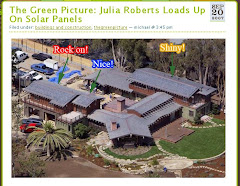Silicon is the major component in the manufacture of solar panel. By developing a cost effective process of isolating silicon from sand, there is a higher probability of reducing the cost of solar panels, and it will be widely accepted and mass produced.
I copied the entire article by Theodore Gray from Popscicom website. To give credit to popular science please visit their website at http://www.popsci.com/popsci/how20/765f9b616d0e6010vgnvcm1000004eecbccdrcrd/2.html. Its a great place to satisfy your appetite for knowledge.
This is really exciting and you guys can improve the process and compound the knowledge of extracting silicon from sand hoping to reduce the cost of producing hyperpure silicon - the main ingredient in the manufacture of solar panels and computers. Here you go:
The industrial economy may someday run out of one of its essential natural resources, oil, but at least the high-tech economy is safe in its supply of silicon, the element that is the key ingredient in every computer processor. Its oxide form, known as silica or quartz, is dirt-common. In fact, it is dirt: Almost all kinds of sand, clay and rock contain silica in one form or another, and overall more than half the Earth's crust is made of silica.
Industrially, silica is converted to pure silicon by heating it with coke (the form of coal, not the drink) in a furnace. But there's an even easier, if less cost-effective, method that I learned from Jason Stainer, a science teacher in England. All you have to do is heat a mixture of common silica sand and magnesium powder in a test tube. The magnesium steals the oxygen atoms from the silica, leaving elemental silicon.
No reaction is perfect, and in this case you're left with a mixture of magnesium, magnesium oxide, magnesium silicide and silicon in the bottom of the test tube. Fortunately, the best way to purify it is also the most entertaining. I told my eight-year-old Harry Potter fan that I had prepared a fire potion.
First pour one cup of what is sold in any hardware store as muriatic acid (37% HCl) into five cups of water. (Not the other way around. The old chemist's saying "Do as you oughta, add acid to watta" is there to protect you from steam explosions that can occur if water is poured into acid instead of acid into water.) Then dump in the contents of the test tube, and you'll get a wonderful frothing mass of flaming bubbles and a lovely mushroom cloud of smoke. This is one of the best can't-fail fire potions. (I can also do levitation potions [Gray Matter, February 2004], although I've had to explain to my daughter that since we live in a Muggle zone, I'm allowed to levitate only very small objects.)
Chemically speaking, several things happen when the powder hits the acid. Any leftover magnesium powder reacts with the acid to produce hydrogen gas. The magnesium silicide reacts with the acid to produce silane gas, which spontaneously combusts on contact with air, giving off little pops that ignite the nearby swirls of hydrogen gas.
If there is still some magnesium powder floating in the air, it catches fire too, creating a bright flash and a puff of white smoke. You get three forms of fire in one, and the powder falling to the bottom of the bowl is purified elemental silicon. Spells are fantasy, but potions are real, and this is a great one.
Click to see a reactive moment. Magnesium, hydrogen and silane burn off while the purified silicon falls to the bottom.





